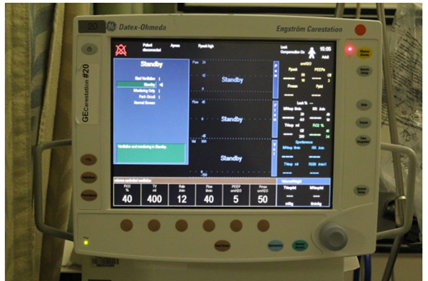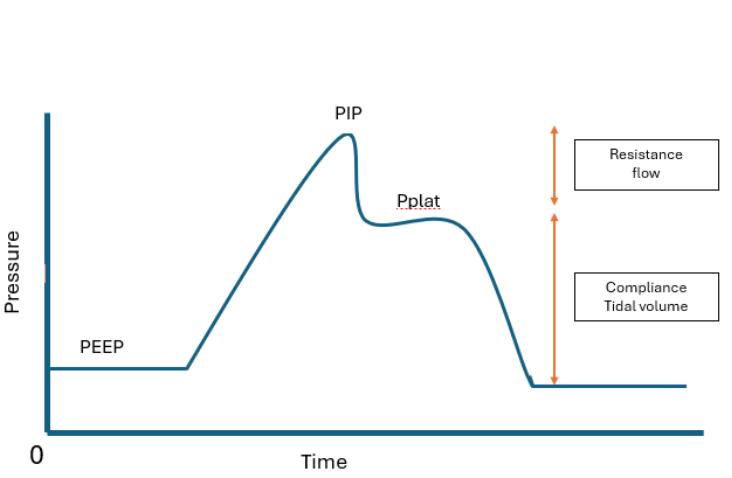2.1 Invasive Mechanical Ventilation
Volume Control
Invasive mechanical ventilation is the primary usage of the volume control. (See Figure 2.[1]) This requires an invasive airway, whether a surgical or mechanically placed airway. The airway considerations are considered elsewhere in this laboratory resource. Volume control is a mode of ventilation, which, in simple terms, is the way that a mechanical ventilator interacts with a patient. Volume control is the name that gives the best way to understand the nature of this mode of ventilation. As you will see, there are multiple ways that this form of mechanical ventilation is referred to, such as assist-control volume control, volume control, or continuous mechanical ventilation-volume control (ACVC, VC, CMV-VC), all of which refer to the same mode of ventilation.
Volume control is typically a straightforward and easy-to-understand mode for respiratory therapists. This mode mimics normal breathing, as minute volume is determined by tidal volume (Vt) multiplied by the number of breaths. In this case, the machine selects both the breath size and the minimum breath rate. The clinician sets the tidal volume (the size of each breath based on the height of the patient) and the respiratory rate (how often a breath is delivered). The breath initiation is called the trigger or the start of a mechanical breath. The ventilator then ensures that the same volume is delivered with each breath, maintaining consistency regardless of the pressure needed to achieve this within the designated timeframe. However, the pressure will vary depending on the resistance of the patient’s airways and the compliance of the patient’s lungs. The patient effort can also trigger a breath; this would be considered non-initiated by the mechanical ventilator.
In most cases, volume control involves managing the set time through a specified flow rate, which is the rate at which the gas comes out of the ventilator into the lungs of the patient. The clinician determines the amount of air to be delivered and how many times the lungs will inflate per minute. However, some ventilators allow the option to set an inspiratory time, or I-time, directly. The inspiratory time is the length of time that it takes for the gas to enter the lungs of the patient. It is helpful to remember that as the flow rate increases, the time of inspiration (or I-time) decreases. Additionally, the maximum flow rate, or the “speed” of air delivery, is set. The I-time is influenced by the chosen flow rate: a higher flow rate results in a shorter I-time to deliver the set volume. These two parameters are inverse of each other.

In assist-control volume control, you will directly set the following:
- Respiratory rate (RR or f)
- Tidal volume (Vt)
- Max flow rate (V) or inspiratory time (I-time)
- PEEP (every ventilator, every mode)
- FiO2 (every ventilator, every mode)
In assist-control volume control, you will observe but not directly set the following:
- Inspiratory pressure
- Peak inspiratory pressure (PIP)
- Inspiratory time (I-time) would not be set if the ventilator lets you set flow. In this case, observe I-time.
In volume control, the volume delivered is constant, but there will be changes in peak pressures (PIP or Ppeak, which refers to the highest pressure experienced by the alveoli during a breath) to achieve the set volume for both the following situations:
- The clinician changing the set parameters (volume, flow/time)
- Breath-to-breath changes based on the compliance and resistance of the lungs
Impacts to peak pressures should be considered by the clinician when making changes, and lung pathology should be considered if changes are noted in the pressure when no adjustments to settings are made. (See Figure 3.[2]) Peak pressures should not be allowed to go too high. Remember that high pressures can cause damage to the alveoli of the lungs. Ideally, plateau pressures should be kept below 30 cmH2O, with a maximum of 35 cmH2O, to ensure the alveoli do not get damaged.

View the following supplementary YouTube video[3] that shows the parameters that should be set when using the volume control mode of mechanical ventilation: Mechanical Ventilation Series: #3 Explanation of Settings (AC Colume Control)
Pressure Control
Pressure control ventilation or assist-control pressure control, pressure control, or continuous mechanical ventilation-pressure control (ACPC, PCV, CMV-PC) is a full control mode of ventilation – the ventilator will control all phases of the breath delivered based on the set parameters. Exhalation is still passive. The clinician sets a minimum of how often breaths will be delivered and sets the positive pressure applied (pressure control) to the lungs that causes the lungs to inflate with volume. The pressure delivered is constant and does not change breath to breath unless the clinician changes it. In contrast to volume control, the control here is the pressure set, and the volume that the patient receives varies according to their pulmonary compliance and airway resistance.
In pressure control, the volume being delivered over time is something that you can trend to see whether the lungs are improving or getting worse. Volumes must be continuously monitored to ensure they are enough to effectively ventilate the patient, but not too high that they cause damage. Pressure control (inspiratory pressure) should be limited to deliver tidal volumes within a safe range for the patient’s lungs.[4]
In PC, you will directly set each of the following:
- Respiratory rate (RR or f)
- Pressure control (PC)
- Inspiratory time (I-time)
- PEEP (every ventilator, every time)
- FiO2 (every ventilator, every time)
In PC pressure control, you will observe but not directly set the following:
- Tidal volume (Vt)
- Inspiratory flow (V)
- I:E
View the following supplementary YouTube video[5] you will differentiate between volume control and pressure control modes of ventilation: Volume versus pressure control
- “Ventilator control panel” by quinn.anya is licensed under a CC BY-SA 4.0. Access for free at https://ecampusontario.pressbooks.pub/mechanicalventilators/chapter/settings-and-definitions/ ↵
- "Pressure time" by Kirsten Holbrook, Chippewa Valley Technical College is licensed under CC BY-NC 4.0 ↵
- RespTherapy. (2016, March 8). Mechanical ventilation series: #3 explanation of settings (AC volume control) [Video]. YouTube. All rights reserved. https://www.youtube.com/watch?v=UkSfJI9zGEk ↵
- Bishop, M. (2022). Basic principles of mechanical ventilation. Sault College. https://ecampusontario.pressbooks.pub/mechanicalventilators/front-matter/introduction/ ↵
- Medmastery. (2017, January 30). Volume versus pressure control [Video]. YouTube. All rights reserved. https://www.youtube.com/watch?v=TJf0tPjIK4Q ↵

